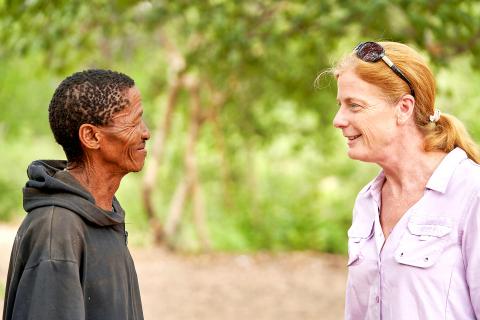A large ancient wetlands region spanning northern Botswana — once teeming with life but now dominated by desert and salt flats — may represent the ancestral homeland of all of the 7.7 billion people on Earth today, researchers said on Monday.
Their study, guided by maternal DNA data from more than 1,200 people indigenous to southern Africa, proposed a central role for this region in the early history of humankind starting 200,000 years ago, nurturing our species for 70,000 years before climate changes paved the way for the first migrations.
A lake that at the time was Africa’s largest — twice the area of today’s Lake Victoria — gave rise to the ancient wetlands covering the Greater Zambezi River Basin that includes northern Botswana into Namibia to the west and Zimbabwe to the east, the researchers said.

Photo: REUTERS
照片:路透
It has been long established that Homo sapiens originated somewhere in Africa before later spreading worldwide. “But what we hadn’t known until this study was where exactly this homeland was,” said geneticist Vanessa Hayes of the Garvan Institute of Medical Research and University of Sydney, who led the study published in the journal Nature.
The oldest-known Homo sapiens fossil evidence dates back more than 300,000 years from Morocco. The new study suggests that early members of our species, as represented by the Morocco remains, may not have left any ancestors living today, the researchers said.
“There is no contradiction between the presence of an early Homo sapiens-like skull in northern Africa, which may be from an extinct lineage, and the proposed southern African origin of the Homo sapiens lineages that are still alive,” added study co-author Axel Timmermann, a climate physicist at Pusan National University in South Korea.
The ancient lake Makgadikgadi began to break up about 200,000 years ago, giving rise to a sprawling wetland region inhabited by human hunter-gatherers, the researchers said. “It can be viewed as a massive extension of today’s Okavango Delta wetland area,” Timmermann said.
Changes in Earth’s axis and orbit caused climate, rainfall and vegetation shifts that set the stage for early migrations of this ancestral group of people away from the homeland region, first toward the northeast 130,000 years ago, then toward the southwest 110,000 years ago, Timmermann added.
“Our study provides the first quantitative and well-dated evidence that astronomically driven climate changes in the past caused major human migration events, which then led to the development of genetic diversity and eventually cultural, ethnic and linguistic identity,” Timmermann added.
(Reuters)
研究人員週一表示,橫跨波札那北部的一大片古老溼地區域──當地曾經充滿生機,現在卻遍布沙漠和鹽灘──也許就是今日地球上所有七十七億人祖先的故鄉。
這份研究參考了一千兩百多名非洲南部原住民的母系DNA資料,從而推論出,該區域在二十萬年前開始的人類早期歷史中扮演著重要角色。這片土地養育著我們物種長達七萬年之久,直到氣候變遷使人類第一次向外遷徙成為可能。
研究人員表示,非洲當時最大的一座湖──面積足足是今日維多利亞湖的兩倍大──形成一大片古老的溼地,涵蓋整片大尚比西河流域,範圍包括波札那北部,向西延伸到納米比亞,向東延伸到辛巴威。
長久以來,科學界早有定論:「智人」起源於非洲某處,後來才擴展到世界各地。澳洲雪梨大學和嘉文醫學研究所的遺傳學家凡妮莎‧海斯,是這篇發表於期刊《自然》的主要作者。她指出:「但是一直到這份研究之前,我們所不知道的是,這個人類原鄉到底位於何處。」
目前已知最古老的智人化石證據可追溯到三十多萬年前,於摩洛哥出土。研究人員表示,這項新研究指出:摩洛哥遺骸所代表我們物種的早期成員,也許並沒有存活下來,成為今日人類的祖先。
南韓釜山國立大學的氣候物理學家阿克塞爾‧提默曼是這篇研究的共同作者。他補充指出:「在北非出現的早期類智人頭骨,也許是來自於一脈已經滅絕的世系,而這份研究提出的智人世系起源於非洲南部,且持續繁衍至今,兩者之間互不牴觸。」
研究人員指出,遠古湖泊「馬卡迪卡迪」大約在二十萬年前開始分裂,形成持續向外蔓延的溼地區域,狩獵採集為生的人類當時就棲息於此。提默曼表示:「可以把它想像成今日奧卡萬戈三角洲溼地區域的巨大延伸。」
提默曼補充說,地軸和地球軌道的改變導致氣候、降雨以及植被發生變化,為這群人類祖先創造出早期遷徙的條件。他們離開家鄉,先在十三萬年前向東北方移動,再於十一萬年前向西南方遷徙。
提默曼指出:「我們的研究提供首次經過量化並仔細定年的證據,顯示過去由天文變化導致的氣候變遷引發大規模的人類遷徙事件,進一步造成遺傳多樣性的發展,最後形塑出文化、種族以及語言等身分認同。」
(台北時報章厚明譯)

Even as he grows older, Microsoft founder Bill Gates still fondly remembers the catalytic computer code he wrote 50 years ago that opened up a new frontier in technology. Although the code that Gates printed out on a teletype machine may look crude compared to what’s powering today’s artificial intelligence platforms, it played a critical role in creating Microsoft in April 1975 — a golden anniversary that the Redmond, Washington, company celebrated on April 4. Gates, 69, set the stage for that jubilee with a blog post reminiscing on how he and his old high school friend — the late Paul Allen

Australia’s strict immigration policies have long been criticized, particularly for how they treat people with disabilities. Having been residents of Australia for years, Scottish Laura Currie and her Italian partner, Dante Vendittelli, recently experienced the impact of these immigration policies. Their son Luca, born in Australia and diagnosed with cystic fibrosis, became the reason their residency application was denied due to the anticipated high healthcare costs. Had Luca been healthy, there would have been no objections to their permanent residency. This case not only highlights discrimination against disabled individuals, but also raises questions about fairness and inclusion within Australia’s immigration

A: After holding nine concerts in Kaohsiung and Taipei recently, “God of Songs” Jacky Cheung will stage three extra shows later this week. B: They’re compensation for the three shows he postponed last year due to illness. A: He also canceled three more shows in Guangzhou last month. His health is worrisome. B: When touring Guangzhou, he dedicated his hit “She Is Far Away” to late singer Khalil Fong. That’s so touching. A: Online music platform KKBOX has also launched a campaign to pay tribute to Fong. I can’t believe he died so young: he was only 41. A:

The study had several issues. Small sample sizes made it hard to draw __7__ conclusions. Additionally, taking a __8__ like pure MSG on an empty stomach is likely to make a person ill in any case. Choosing individuals who already had a history of the symptoms could have created a bias because they were likely to __9__ the reactions again. When real scientific research on the effects of MSG was eventually done, many of the myths surrounding it were proven __10__. The U.S. Food and Drug Administration and other global organizations have found MSG safe to eat. Today, MSG